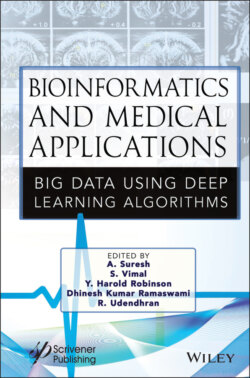Читать книгу Bioinformatics and Medical Applications - Группа авторов - Страница 68
3.1 Introduction
ОглавлениеThe discipline called Proteomics focuses, among other things, on the prediction of the predominant function of proteins, since this enables their construction by alteration or removal of their amino acids, either in its linear or in its three-dimensional representation.
This means some benefits for scholars of this discipline; since from these modifications, it is possible to obtain, mostly by accident, proteins with improved toxic action toward some pathogen.
Of course, it does not mean that there are no proteins or peptides in nature that have the toxic action we are looking for, it is just that in most cases, it is less expensive to try to manufacture one than to find it among the many organisms in nature.
The proteins expressing the SARS-CoV-2 that caused the COVID-19 pandemic have the particularity that their linear representation, i.e., their sequence, has a large number of amino acids, approximately 2,400 amino acids (aa). To give the reader an idea of the complexity and dimension of it, let us consider that some short peptides with antibacterial action have an average of 9aa.
Now, the capacity and robustness of the SARS-CoV-2 and all the regulatory processes can be dimensioned. Viruses, in general, have not simple mechanisms; they occupy some microns in length (a micron equals a thousand of a millimeters), but they are specialized organisms with multiple properly regulated functions that are characterized, among other things, for completing themselves when they are in contact with the RNA or DNA of the host.
This particularity suggests that they are not living organisms if we compare them with other living organisms whose species are known. Living organisms are born complete and do not get completed at birth; they have everything to reproduce themselves. This is not so with viruses; in any case, we can say that viruses are another type of life.
The SARS-CoV-2 is a virus of the group of coronaviruses, whose particularity and strength is the possibility of reproducing in any living organism. This feature is not shared by all viruses, e.g., the Ebola virus only passes to certain species, despite its lethality that is greater than 60%, it is less dangerous to our species because, when it kills its host, the virus dies with it and the damage is so fast that the number of deaths is small.
This does not occur with SARS-CoV-2 that can spread rapidly and the infected subject does not show any symptoms (asymptomatic) for 4 or up to 7 days, despite its lethality rate that is no higher than 2%.
From the above, it is clear that the definition of the lethality rate is not just a quotient, but multiple variables have to be considered. Almost as many as asking us about the lethality of a human being.
The review of the basic concepts related to viruses and particularly the SARS-CoV-2, make us think about the complexity of these organisms, not as organisms that by their small size are simple and potentially fragile, but as organisms with an auto-regulatory capacity as complex as the human species but in a few microns.
